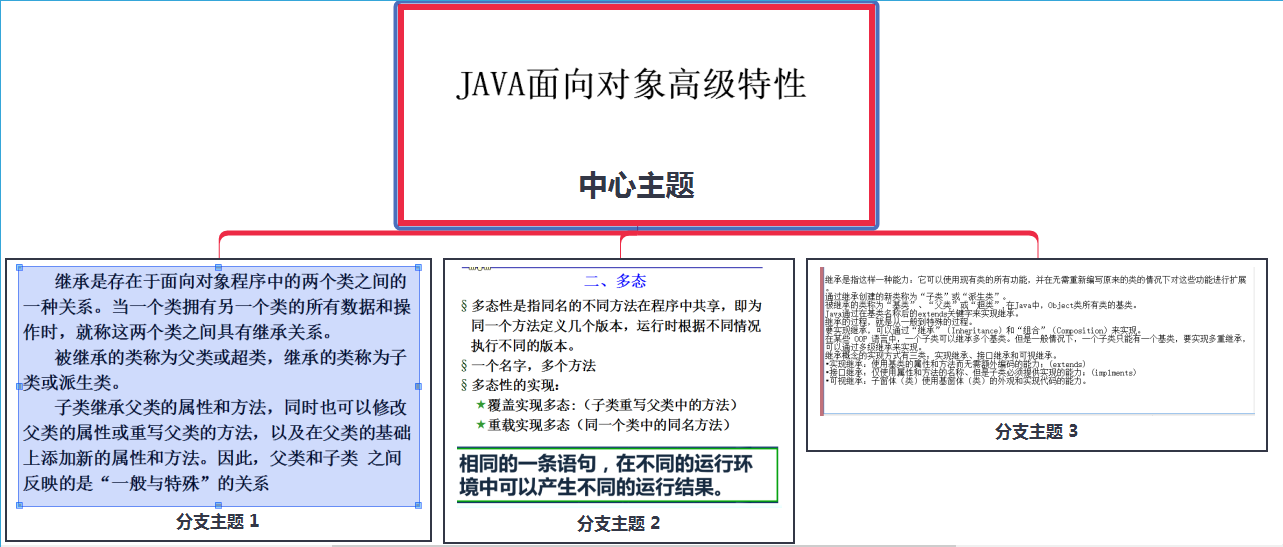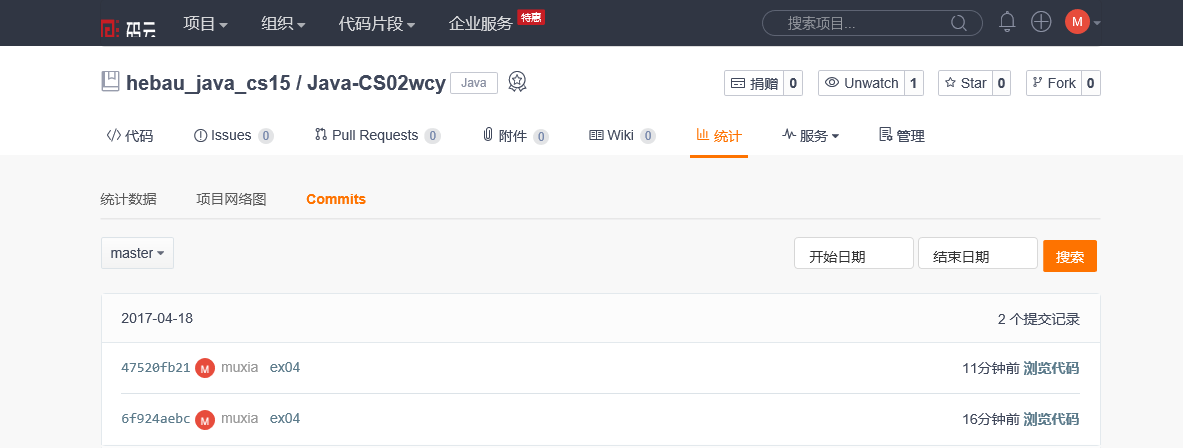(一)学习总结
1.学习使用思维导图对Java面向对象编程的知识点(封装、继承和多态)进行总结。
XMind中,用户可以自由、灵活的设计流程图。
2.阅读下面程序,分析是否能编译通过?如果不能,说明原因。应该如何修改?程序的运行结果是什么?为什么子类的构造方法在运行之前,必须调用父类的构造方法?能不能反过来?
class Grandparent {
public Grandparent() {
System.out.println("GrandParent Created.");
}
public Grandparent(String string) {
System.out.println("GrandParent Created.String:" + string);
}
}
class Parent extends Grandparent {
public Parent() {
System.out.println("Parent Created");
super("Hello.Grandparent.");
}
}
class Child extends Parent {
public Child() {
System.out.println("Child Created");
}
}
public class Test{
public static void main(String args[]) {
Child c = new Child();
}
}不能通过编译
构造函数的调用必须是构造函数中的第一个语句,子类的构造方法必须先调用父类构造,再执行子类构造
修改如下:
class Parent extends Grandparent {
public Parent() {
super("Hello.Grandparent.");
System.out.println("Parent Created");
}
}修改后运行结果为:
GrandParent Created.String:Hello.Grandparent.
Parent Created
Child Created子类无条件地继承父类的不含参数的构造方法。
两者不能反过来,即若子类定义了自己的构造方法,它先执行继承自父类的无参数构造方法,再执行自己的构造方法。
3 . 阅读下面程序,分析程序中存在哪些错误,说明原因,应如何改正?正确程序的运行结果是什么?
class Animal{
void shout(){
System.out.println("动物叫!");
}
}
class Dog extends Animal{
public void shout(){
System.out.println("汪汪......!");
}
public void sleep() {
System.out.println("狗狗睡觉......");
}
}
public class Test{
public static void main(String args[]) {
Animal animal = new Dog();
animal.shout();
animal.sleep();
Dog dog = animal;
dog.sleep();
Animal animal2 = new Animal();
dog = (Dog)animal2;
dog.shout();
}
}错误:没有为类型 Animal 定义方法 sleep() ,类型不匹配:不能从 Animal 转换为 Dog
修改如下:
class Animal{
void shout(){
System.out.println("动物叫!");
}
void sleep(){
System.out.println("动物睡觉");
}
}
class Dog extends Animal{
public void shout(){
System.out.println("汪汪......!");
}
public void sleep() {
System.out.println("狗狗睡觉......");
}
}
public class Test{
public static void main(String args[]) {
Animal animal = new Dog();
animal.shout();
animal.sleep();
Dog dog = (Dog)animal;
dog.sleep();
Animal animal2 = new Dog();
dog = (Dog)animal2;
dog.shout();
}
}运行结果:
4.运行下列程序
class Person {
private String name ;
private int age ;
public Person(String name,int age){
this.name = name ;
this.age = age ;
}
}
public class Test{
public static void main(String args[]){
Person per = new Person("张三",20) ;
System.out.println(per);
System.out.println(per.toString()) ;
}
}(1)程序的运行结果如下,说明什么问题?
Person@166afb3
Person@166afb3问题:System.out.println(per); per无论有没有调用toString()方法,都输出了类名和地址信息,都会调用object中toString()方法
System.out.println(per.toString()) ;
(2)那么,程序的运行结果到底是什么呢?利用eclipse打开println(per)方法的源码,查看该方法中又调用了哪些方法,能否解释本例的运行结果?
(3)在Person类中增加如下方法
public String toString(){
return "姓名:" + this.name + ",年龄:" + this.age ;
} 重新运行程序,程序的执行结果是什么?说明什么问题?
结果:
问题:“子类Person类覆写了Object类中toString()方法”。
可参考教材P229
(二)实验总结
实验内容:
1.定义员工类,具有姓名、年龄、性别属性,并具有构造方法和显示数据方法。定义管理层类,继承员工类,有自己的属性职务和年薪。定义职员类,继承员工类,并有自己的属性所属部门和月薪。定义一个测试类,进行测试。画出类图。
工具:ProcessOn
参考资料:UML 类图
程序设计思路:创建员工父类:包括年龄,姓名,性别等构造方法。创建子类:管理类,职务类继承父类的构造方法,并继续执行自己的构造方法。
问题:
开始理解不了父类和子类的继承之间的关系。
之后通过课本和讲课PPT深入了解之后明白了两者之间的关系以及如何使用
2.按照下面要求完成类的设计
(1)设计一个平面图形抽象类(提供求该类对象周长和面积的方法)和一个立体图形抽象类(提供求该类对象表面积和体积的方法)
(2)设计球类、圆柱类,圆锥类、矩形类、三角形类、圆类,分别继承平面图形抽象类和立体图形抽象类。
(3)建立测试类,进行测试。画出类图。
程序设计思路:跟1题类似创建父类、子类构造方法,子类继承父类并执行自己的构造方法
(三)代码托管(务必链接到你的项目)
•码云commit历史截图
上传实验项目代码到码云,在码云项目中选择“统计-commits”,设置搜索时间段,搜索本周提交历史,并截图。
截图:
链接:http://git.oschina.net/hebau_cs15/Java-CS02wcy







 本文总结了Java面向对象编程的基本概念,包括封装、继承和多态,并通过具体代码示例展示了构造方法的调用顺序、方法重写及多态性的应用。
本文总结了Java面向对象编程的基本概念,包括封装、继承和多态,并通过具体代码示例展示了构造方法的调用顺序、方法重写及多态性的应用。

















 被折叠的 条评论
为什么被折叠?
被折叠的 条评论
为什么被折叠?








